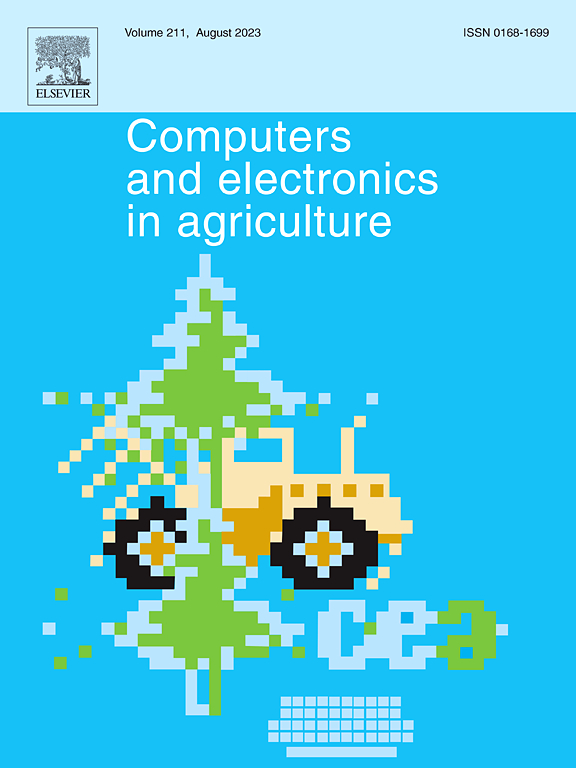Strawberry fruit yield forecasting using image-based time-series plant phenological stages sequences
IF 7.7
1区 农林科学
Q1 AGRICULTURE, MULTIDISCIPLINARY
引用次数: 0
Abstract
Yield forecasting is crucial for growers, enabling efficient resource management and informed decision-making. Such decisions impact storage, product processing, and logistics, leading to increased productivity and cost savings. However, this heavily relies on accurate yield forecasts. This work addresses such a need by presenting the development and testing of a reliable method for yield forecasting. The proposed methodology combines high-resolution object detection with a multi-variate input forecasting model that accurately computes the yield for incoming harvests. The forecasting approach incorporates a physically-constrained model based on a Long Short-Term Memory (LSTM) network. This model dynamically applies weights to the time-series data composed of counts for the phenological stages: flower, green, small white, large white, pink, and red (ripe fruit). These counts are obtained from detections made by a YOLOv10s, achieving an mAP@50 of 0.74 for all classes. As a result, the forecasting model’s capacity to interpret input data is enhanced, translating it into a valid ripe count forecast. To validate the proposed approach, the forecasting model was trained and evaluated using (a) untreated count sequences and (b) weighted count sequences. The results indicate that phenologically-weighted input sequences outperform untreated sequences, with the following evaluation metrics: R = 0.74, Root Mean Square Error (RMSE) = 12.67, Mean Absolute Error (MAE) = 10.95, and Mean Absolute Percentage Error (MAPE) = 39.4, improving 15%, 19.26%, 17.13%, and 11.3%, respectively.
基于图像的时序植物物候期序列预测草莓果实产量
产量预测对种植者来说至关重要,可以实现有效的资源管理和明智的决策。这些决策影响存储、产品加工和物流,从而提高生产率并节省成本。然而,这在很大程度上依赖于准确的产量预测。这项工作通过提出一种可靠的产量预测方法的开发和测试来解决这样的需求。提出的方法结合了高分辨率目标检测和多变量输入预测模型,该模型可以准确计算即将收获的产量。该预测方法结合了基于长短期记忆(LSTM)网络的物理约束模型。该模型动态地将权重应用于由物候阶段组成的时间序列数据:花、绿、小白、大白、粉红和红色(成熟的水果)。这些计数是从YOLOv10s进行的检测中获得的,所有类别的mAP@50均为0.74。因此,预测模型对输入数据的解释能力得到增强,将其转化为有效的成熟计数预测。为了验证所提出的方法,使用(a)未经处理的计数序列和(b)加权计数序列对预测模型进行训练和评估。结果表明,物候加权输入序列优于未处理序列,R2 = 0.74,均方根误差(RMSE) = 12.67,平均绝对误差(MAE) = 10.95,平均绝对百分比误差(MAPE) = 39.4,分别提高了15%,19.26%,17.13%和11.3%。
本文章由计算机程序翻译,如有差异,请以英文原文为准。
求助全文
约1分钟内获得全文
求助全文
来源期刊

Computers and Electronics in Agriculture
工程技术-计算机:跨学科应用
CiteScore
15.30
自引率
14.50%
发文量
800
审稿时长
62 days
期刊介绍:
Computers and Electronics in Agriculture provides international coverage of advancements in computer hardware, software, electronic instrumentation, and control systems applied to agricultural challenges. Encompassing agronomy, horticulture, forestry, aquaculture, and animal farming, the journal publishes original papers, reviews, and applications notes. It explores the use of computers and electronics in plant or animal agricultural production, covering topics like agricultural soils, water, pests, controlled environments, and waste. The scope extends to on-farm post-harvest operations and relevant technologies, including artificial intelligence, sensors, machine vision, robotics, networking, and simulation modeling. Its companion journal, Smart Agricultural Technology, continues the focus on smart applications in production agriculture.
 求助内容:
求助内容: 应助结果提醒方式:
应助结果提醒方式:


